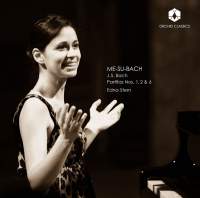Texte paru dans: / Appeared in: |
||||
|
Outil de traduction ~ (Très approximatif) |
||||
|
Reviewer: Huntley
Dent It’s been six decades since Glenn Gould planted his flag on behalf of playing Bach on the piano, but the issue still calls for a rationale. The Belgian-Israeli pianist Edna Stern offers a strong personal viewpoint: “I believe that the music of Bach requires a vocally-inspired interpretation.” That’s quite an unusual stance for a keyboardist, although the six Partitas were composed in Leipzig between 1726 and 1731, during the same period as the St. Matthew Passion. In simplified form, Stern’s argument focuses on playing Bach with warmth and expression. Pedaling, after all these years of back-and-forth, remains an issue. She favors discreetly used pedal, pointing out that Bach was, after all, an organist. The Partitas are notable as the first works Bach himself guided through publication, but they are among his last keyboard suites to be composed. The title page describes them didactically as Clavier-Übung, which Stern translates as “Clavichord Studies,” but in the extended title, which names all the dances that comprise the Partitas—Allemande Sarabande, Courante, Menuet, Gigue, etc.—Bach also says that pedagogy isn’t the main aim but a “pleasurable diversion for music-lovers.” Stern, who was born in Belgium in 1977, grew up in Israel, and now teaches at the Royal College of Music in London, writes a brief, engaging program note to make these points, yet what’s more important is that she can illustrate them with such deft, spirited, and appealing performances. Pianists who take up Bach’s keyboard works must make a decision first off whether to imitate the harpsichord or take advantage of the vast expressive potential of the piano. Stern falls decidedly on the pianistic side of the divide, putting herself in league with one of my favorite Bach interpreters, Piotr Anderszewski, who recorded Partitas 1, 3, and 6 in 2002 (Erato). Both players employ, at their discretion, coloristic devices, rubato, and shifting dynamics. Anderszewski is more radically stylized than Stern, but she provides just as much musical enjoyment—and earns our intellectual respect at the same time. That’s because Stern is able to balance all the essential elements of Bach’s complex, nuanced style, and does so with apparent ease. The Partitas can be intricate and dramatic (the Sinfonia of No. 2), light and playful (the Rondeaux of the same work), stately and dignified (any number of allemandes and sarabandes), and much more. Stern adapts to these changes with “rigor and vigor,” as she puts it. Every phrase is animated and involved, yet on technical terms she also makes sure to clarify textures, keep the leading voice in focus, never lose sight of the lyric line, and remind us continually that Bach was inspired by the dance. Orchid Classics’ recorded sound is vivid and lifelike—we are placed on the piano bench next to the performer, which creates impact and intimacy at the same time. The surrounding acoustic is warmly inviting. In short, Stern has satisfied the requirements of a “vocally-inspired” style that aims to touch our hearts the way singing does. It’s worth noting that Stern, a pupil of Krystian Zimerman and Martha Argerich, has also delivered historically informed performances on the fortepiano. On this occasion, however, adherents of HIP Bach and period instruments will be waiting for the bus at the corner. The rest of us will be very pleased with the music-making on this outstanding recital. | ||||
|
||||
|
|
|
|||
|
Cliquez l'un ou l'autre
bouton pour découvrir bien d'autres critiques de CD |
||||




